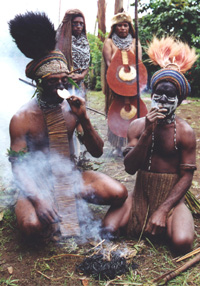
Photo. One of the tribes in the highland in Papua New Guinea. © Travel Explorations.
Michael "Mick" James Leahy MBE (26 February 1901 - 7 March 1979) was an Australian explorer and colonialist, famed for his discovery of the Highlands area of Papua New Guinea. He photographed, filmed and published many of his explorations widely. http://en.wikipedia.org/wiki/Mick_Leahy
State of Papua New Guinea, is a country in Oceania, occupying the eastern half of the island of New Guinea and numerous offshore islands (the western portion of the island is a part of the Indonesian provinces of Papua and West Papua). It is located in the southwestern Pacific Ocean, in a region defined since the early 19th century as Melanesia. The capital is Port Moresby.
The National Library is one of several agencies within the Department of the Prime Minister and Cabinet portfolio with responsibility for maintaining and disseminating Australia's cultural heritage.
http://www.nla.gov.au/apps/cdview?pi=nla.pic-an20650880&referercode=cat
The Library’s role, as defined by the National Library of Australia Act 1960, is to ensure that documentary resources of national significance relating to Australia and the Australian people, as well as significant non-Australian library materials, are collected, preserved and made accessible either through the Library itself or through collaborative arrangements with other libraries and information providers.
Papua New Guinea is one of the most culturally diverse countries on Earth, with over 850 indigenous languages and at least as many traditional societies, out of a population of just under seven million. It is also one of the most rural, as only 18% of its people live in urban centres.[6] The country is one of the world's least explored, culturally and geographically, and many undiscovered species of plants and animals are thought to exist in the interior of Papua New Guinea.
Little was known in the West about the island until the nineteenth century, although Portuguese and Spanish explorers such as Dom Jorge de Meneses and Yñigo Ortiz de Retez respectively had encountered it as early as the sixteenth century.
Papua New Guinea is one of the most heterogeneous nations in the world. There are hundreds of ethnic groups indigenous to Papua New Guinea, the majority being from the group known as Papuans, whose ancestors arrived in the New Guinea region tens of thousands of years ago. Many remote Papuan tribes still have only marginal contact with the outside world.
The others are Austronesians, their ancestors having arrived in the region less than four thousand years ago. There are also numerous people from other parts of the world now resident, including Chinese, Europeans, Australians, Filipinos, Polynesians and Micronesians. At the brink of Papuan independence in 1975, there were 40,000 expatriates (mostly Australian and Chinese) in Papua New Guinea.
Papua New Guinea has more languages than any other country, with over 820 indigenous languages, representing twelve percent of the world's total, but most have fewer than 1,000 speakers.
Stein Morten Lund, 5th November 2011












